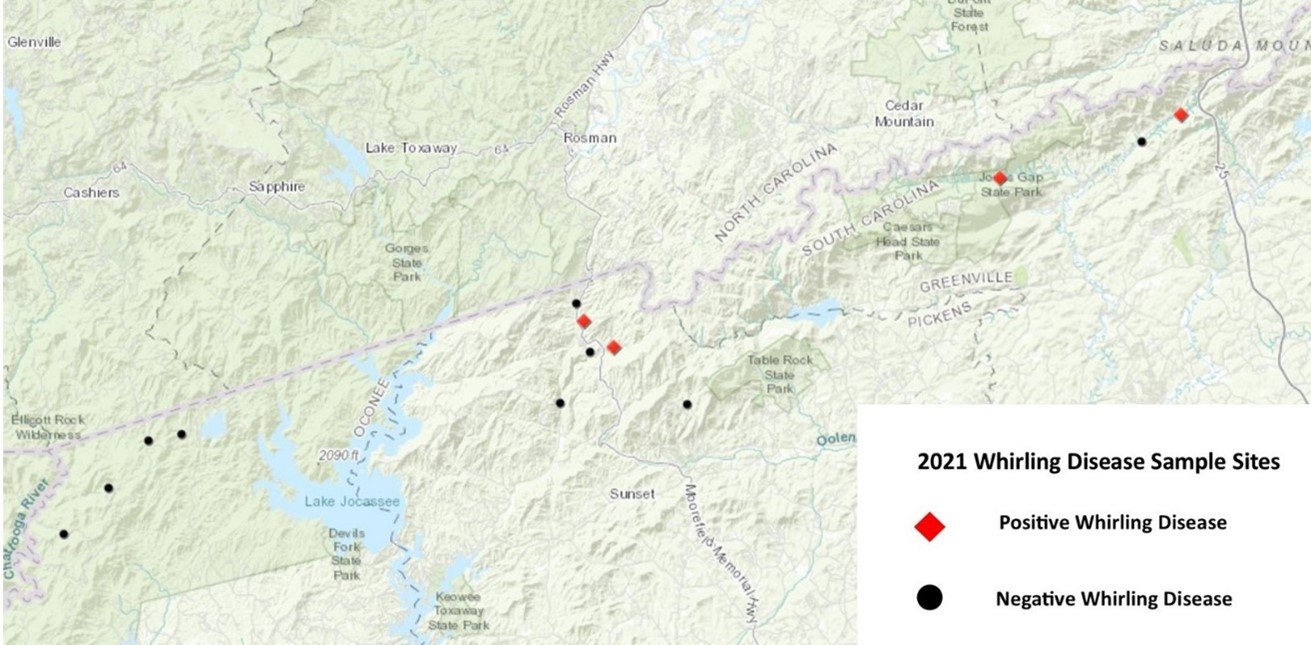Trout - Whirling Disease
Whirling disease is a parasitic infection caused by a microscopic parasite known as Myxobolus cerebralis, which attacks the cartilage tissues of the head and spine. Found in trout and salmon species, fish infested with this parasite may develop symptoms that include a whirling behavior, head deformities, twisted spines and black tails. Young rainbow trout populations infested with whirling disease may experience mortality rates as high as 90%. The parasite itself doesn’t directly kill its host, but infested fish are more susceptible to predation, have difficulty eating and are less likely to survive distributions in their environment.
Whirling Disease in South Carolina
In coordination with the U.S. Fish and Wildlife Service’s Wild Fish Health Project, SCDNR has conducted long term surveillance for exotic trout pathogens in wild trout populations and at our Walhalla State Fish Hatchery. Beginning in 2015, SCDNR increased surveillance for whirling disease and other exotic pathogens in trout due to documented outbreaks of whirling disease and two additional species of parasitic gill lice in nearby states.
In March 2022, the S.C. Department of Natural Resources’ Wildlife and Freshwater Fisheries Division, working with the Southeastern Fish Disease Cooperative at Auburn University, documented the presence of whirling disease for the first time in four streams sampled in Pickens and Greenville counties. This represents the first positive diagnosis of the whirling disease pathogen in South Carolina trout streams.
The fish found to be infected with whirling disease in South Carolina did not present with the symptoms normally associated with the disease. A recent fish health inspection at Walhalla State Fish Hatchery in Oconee County was negative for whirling disease and other new exotic pathogens.

To monitor the status of whirling disease in South Carolina, freshwater fisheries staff will continue to collect samples for disease analysis during summer/fall survey seasons.
The parasite that causes whirling disease has a complex, two host life cycle. The first being fish from the salmonid (trout and salmon) family. When an infested fish dies, several hard, cold and drought resistant spores are released into the environment. These spores become a food source for the second host, a common bottom dwelling aquatic worm. When the spores, know as triactinomyxons or TAMS are released from the tubifex worm they attach and enter new fish hosts through the skin.
The lack of any known treatment for trout or streams found to be infested with the Myxobolus cerebralis parasites makes it vital for anglers and boaters to help stop the spread of Whirling Disease.
Never transport live fish from one water body to another. Excess bait should only be released into the water body from which it came. All bait purchased at a local bait store or collected from a different water body must be discarded through trash or compost.
Do not dispose of unused portions of fish in or near any water body. Spores that cause whirling disease can survive the death of the fish and infest waters through the disposal of fish heads and entrails. All unused portions of fish should be disposed in dry trash or deep burying.
Always take the time to properly clean your gear. Anglers that do not properly clean their boats, trailers, waders, boots and other gear between fishing trips may inadvertently transport dangerous aquatic hitchhikers. To remove aquatic hitchhikers, always Clean.Drain.Dry!
Anglers and boaters that frequent different water bodies must clean their wading gear, rinse and thoroughly dry before entering the next lake, river or stream. To be effective in stopping the transport of disease, you should use a 3% bleach solution, completely rinsing to prevent damage to your gear and ensure it is completely dry. Gear may also be soaked in a 1% salt or 100% vinegar for 20 minutes for a similar result.
For rivers and streams where disease has been confirmed, use a 10% bleach solution and allow to soak approximately 10 minutes.
- Take photos/video of the fish, including close ups of the head and spine.
- Note where the fish was caught, including water body, GPS coordinates or identifying landmarks.
- Properly clean your boat, trailer and gear.
- Maintain your catch and await further guidance from your regional freshwater fisheries staff.

